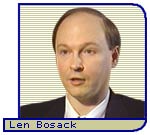 |
|||
 |
|||
![]() Adult Supervision
Adult Supervision
Only one year after Sun was formed, another company destined to make a big splash in the networking world was also based on work done at Stanford. Cisco, founded by husband and wife Len Bosack and Sandy Lerner, started experimenting with connecting their two detached networks located in two different buildings on campus. With the help of two other Stanford staff members, Bosack and Lerner ran network cables between the buildings and connected them first with bridges and then routers.
Bosack's router was really an updated IMP, which would transmit only the traffic that was meant to get out and accept only the traffic that was meant to get in. Bosack and Lerner designed and built routers in their house and experimented using Stanford's network. When word got out about their routers, other universities and research centers asked to buy them. Bosack and Lerner went to Stanford with a propositio

n to start building and selling the routers, but the school refused. Bosack and Lerner knew they had something worthwhile, so they founded their own company and named it "Cisco," taken from the name of the city to the north.
Their house became company headquarters and every
room was used for building, testing, manufacturing, or shipping.
 They had no capital, so they charged all the startup costs on their credit
cards. However, even without a real sales staff, they started to make
a profit very quickly. When they were pulling in hundreds of thousands
of dollars every month, they decided it was time to act like a real
business, and they needed help recreating their company.
They had no capital, so they charged all the startup costs on their credit
cards. However, even without a real sales staff, they started to make
a profit very quickly. When they were pulling in hundreds of thousands
of dollars every month, they decided it was time to act like a real
business, and they needed help recreating their company.
They went to several venture capitalists and made their pitch, but all refused until the 77th:
"At that point I think we were -- Cisco was doing, I think, a quarter million, maybe 350,000 a month without a professional sales staff and without an official conventionally recognized marketing campaign. So it wasn't a bad business just right then. And so I think just for the novelty of it, the folks at Sequoia listened to us."
Len Bosack
cofounder of Cisco
Don Valentine was an experienced venture capitalist with such companies as Apple and 3Com in his portfolio. He saw great potential in Cisco and he was impressed with Bosack's and Lerner's enthusiasm. However, he wanted to hire some experienced management to run the business - something venture capitalists call "adult supervision."
"The commitment we jointly made to each other is that we at Sequoia would do a number of things. We would provide the financing, we would find and recruit management, and we would help create a management process. None of which existed in the company when we arrived."
Don Valentine
Sequoia Capital
 Valentine
recruited John P. Morgridge as president and CEO to oversee the company
and be Bosack's and Lerner's boss. There was tension between the three
from the start, and Lerner claims that the first words from Morgridge's
mouth when they met were "I hear that you're everything that's wrong
with Cisco." He denies he ever said that, but Lerner never got along
with Morgridge after that.
Valentine
recruited John P. Morgridge as president and CEO to oversee the company
and be Bosack's and Lerner's boss. There was tension between the three
from the start, and Lerner claims that the first words from Morgridge's
mouth when they met were "I hear that you're everything that's wrong
with Cisco." He denies he ever said that, but Lerner never got along
with Morgridge after that.
As Cisco grew to a billion dollar business, more management was added and Bosack and Lerner were feeling pushed out. Lerner was always concerned about customer relations, but she didn't get along with the upper management. In 1990, seven of the vice presidents came as a group to Valentine (with Morgridge's knowledge) and made an ultimatum, either Lerner left or they would leave. On August 28th Sandy was asked to leave the company, and Bosack left after he heard. They both immediately sold their two-thirds stake in Cisco, taking about 170 million dollars.
Sandy Lerner now owns a cosmetics line and funds several charities. To get away from California, she bought Ayershire Farms, the 40 room house in Virginia where Jane Austen wrote her novels. She is still bitter about her experiences at Cisco. Although she had separated from her husband Len, they are still close friends and manage a trust that funds several charities. After leaving Cisco, Bosack started his own company, XKL,in Redmond, Washington and also funds charities including SETI (the Search for Extra-Terristrial Intelligence).
Cisco has grown even more since 1990, now valued at over 6 billion dollars and controls over three quarters of the router business. Morgridge is still president and CEO, and has directed Cisco's growth through aggressive marketing and acquisitions including new ventures into ATM and gigabit Ethernet.
Copyright © 1998, PBS Online,
Inc. All Rights Reserved.
Site Designed and Developed by
OPB Learning Media